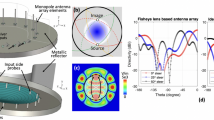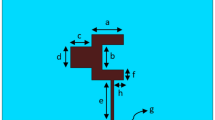Abstract
The aim of this work is to propose a wideband high-gain four-element (2 × 2) lens array antenna with operating frequency in an important region of the electromagnetic spectrum which is key for next-generation high-rate communication. Frequency- and time-domain methods were used to analyze the antenna, with time-domain simulations being preferred. The antenna design started from a basic wideband microstrip antenna on Rogers RO 4350 substrate. Next, to increase the basic antenna gain, a dielectric half-sphere lens was used. Subsequently, the lens antenna was utilized as an array element to form the proposed four-element array antenna. The proposed array antenna exhibited fractional bandwidth of 98.8 % from 34.4 to 101.6 GHz with maximum gain of 16.9 dB at 101.5 GHz. Interesting computational results are presented and discussed in terms of run time, maximum utilized memory, and number of mesh cells for each development step of the antenna. Finally, the antenna was mounted on top of a 24-pin integrated circuit (IC); its three-dimensional (3D) radiation pattern at 60 GHz is presented and discussed.
















Similar content being viewed by others
References
Pi, Z., Khan, F.: An introduction to millimeter-wave mobile broadband systems. IEEE Commun. Mag. 49, 101–107 (2011)
Rangan, S., Rappaport, T.S., Erkip, E.: Millimeter-wave cellular wireless networks: potentials and challenges. Proc. IEEE 102, 366–385 (2014)
Fisher, R.: 60 GHz WPAN standardization within IEEE 802.15.3c. In: 2007 International Symposium on Signals, Systems and Electronics, pp. 103–105 (2007)
Ichkov, A., Atanasovski, V., Gavrilovska, L.: Potentials for application of millimeter wave communications in cellular networks. Wirel. Pers. Commun. 92, 279–295 (2017)
Banerjee, P., Acharyya, A., Biswas, A., Bhattacharjee, A.K.: Effect of magnetic field on the RF performance of millimeter-wave IMPATT source. J. Comput. Electron. 15, 210–221 (2016)
Bandyopadhyay, A.M., Acharyya, A., Banerjee, J.P.: Multiple-band large-signal characterization of millimeter-wave double avalanche region transit time diode. J. Comput. Electron. 13, 769–777 (2014)
Acharyya, A., Banerjee, S., Banerjee, J.P.: Influence of skin effect on the series resistance of millimeter-wave IMPATT devices. J. Comput. Electron. 12, 511–525 (2013)
Rappaport, T.S., Sun, S., Mayzus, R., Zhao, H., Azar, Y., Wang, K., Wong, G.N., Schulz, J.K., Samimi, M., Gutierrez, F.: Millimeter wave mobile communications for 5G cellular: it will work! IEEE Access 1, 335–349 (2013)
Liu, D., Pfeiffer, U., Grzyb, J., Gaucher, B.: Advanced Millimeter-Wave Technologies: Antennas, Packaging and Circuits. Wiley, Hoboken (2009)
Jha, K.R., Singh, G.: Analysis and design of rectangular microstrip antenna on two-layer substrate materials at terahertz frequency. J. Comput. Electron. 9, 68–78 (2010)
Jha, K.R., Singh, G.: Dual-band rectangular microstrip patch antenna at terahertz frequency for surveillance system. J. Comput. Electron. 9, 31–41 (2010)
Jha, K.R., Singh, G.: Analysis and design of terahertz microstrip antenna on photonic bandgap material. J. Comput. Electron. 11, 364–373 (2012)
Singhal, S.: Asymmetrically fed octagonal Sierpinski band-notched super-wideband antenna. J. Comput. Electron. 16, 210–219 (2017)
Gupta, L., Dwivedi, A.D.D.: Suppression of coupling in a microstrip antenna array by grounded defective strips in Bluetooth devices. J. Comput. Electron. 17, 436–441 (2018)
Barkat, O.: Modeling and optimization of radiation characteristics of triangular superconducting microstrip antenna array. J. Comput. Electron. 13, 657–665 (2014)
Koutsoupidou, M., Karanasiou, I.S., Uzunoglu, N.: Substrate constructed by an array of split ring resonators for a THz planar antenna. J. Comput. Electron. 13, 593–598 (2014)
Hao, Z.C., Li, B.W.: Developing wideband planar millimeter-wave array antenna using compact magneto-electric dipoles. IEEE Antennas Wirel. Propag. Lett. 16, 2102–2105 (2017)
Hosono, R., Uemichi, Y., Han, X., Guan, N., Nakatani, Y.: A Bandwidth-enhanced millimeter-wave microstrip comb-line array antenna with parasitic elements on liquid crystal polymer substrate. In: 2014 IEEE Antennas and Propagation Society International Symposium (APSURSI), pp. 1726–1727 (2014)
Parment, F., Ghiotto, A., Vuong, T.P., Duchamp, J.M., Wu, K.: Millimetre-wave air-filled substrate integrated waveguide slot array antenna. Electron. Lett. 53, 704–706 (2017)
Lee, B., Yoon, Y.: Low-profile, low-cost, broadband millimeter-wave antenna array for high-data-rate WPAN systems. IEEE Antennas Wirel. Propag. Lett. 16, 1957–1960 (2017)
Qureshi, A.A., Klymyshyn, D.M., Tayfeh, M., Mazhar, W., Börner, M., Mohr, J.: Template-based dielectric resonator antenna arrays for millimeter-wave applications. IEEE Trans. Antennas Propag. 65, 4576–4584 (2017)
Li, Y., Luk, K.M.: A multibeam end-fire magnetoelectric dipole antenna array for millimeter-wave applications. IEEE Trans. Antennas Propag. 64, 2894–2904 (2016)
Wang, P., Li, Y., Peng, Y., Liew, S.C., Vucetic, B.: Non-uniform linear antenna array design and optimization for millimeter-wave communications. IEEE Trans. Wirel. Commun. 15, 7343–7356 (2016)
Sadiku, M., Chen, C.: Numerical Techniques in Electromagnetics, 2nd edn. CRC Press, Boca Raton (2000)
Thomas, J.W.: Numerical Partial Differential Equations: Finite Difference Methods. Springer, New York (2013)
Jha, K.R., Singh, G.: Analysis of narrow terahertz microstrip transmission-line on multilayered substrate. J. Comput. Electron. 10, 186–194 (2011)
Collin, R.E.: Foundations for Microwave Engineering. Wiley, Hoboken (2007)
Hao, Y., Mittra, R.: FDTD Modeling of Metamaterials: Theory and Applications. Artech House, Norwood (2008)
Berenger, J.P.: The Huygens subgridding for the numerical solution of the Maxwell equations. J. Comput. Phys. 230, 5635–5659 (2011)
Author information
Authors and Affiliations
Corresponding author
Rights and permissions
About this article
Cite this article
Faridani, M., Ghalamkari, B. Four-element lens array antenna for advanced point-to-(multi)point high-bandwidth wireless communication. J Comput Electron 17, 1082–1089 (2018). https://doi.org/10.1007/s10825-018-1204-y
Published:
Issue Date:
DOI: https://doi.org/10.1007/s10825-018-1204-y




